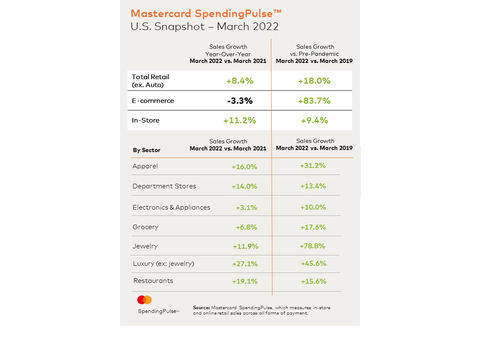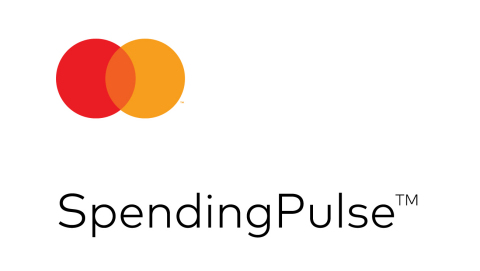PURCHASE, N.Y.--(BUSINESS WIRE)--As we lapped two years since the first Covid lockdowns, March reinforced the ongoing rebalance to pre-pandemic ways of consumer spending. From airlines to lodging, spending on services is making its comeback, while in-store retail sales are rebounding as consumer mobility increases. According to Mastercard SpendingPulse™, which measures in-store and online retail sales across all forms of payment, total retail sales excluding auto increased 8.4% year-over-year (YOY) and 18.0% compared to pre-pandemic spending (2019), not adjusted for inflation. This is similar to the YOY growth experienced last month and slightly above January growth levels.
While the pandemic and lockdowns may have temporarily limited where consumers could spend their paychecks and free time, key trends for March 2022 highlight the diversification of consumer spending across sectors and channels. Of note:
- Goods AND services: Airline spending took flight as the highly anticipated return to travel drove YOY airline growth up 44.8% in March, while Restaurants (+19.1%) and Lodging (+46.4%) also grew significantly. But an increase in services didn’t halt spending on goods as the Luxury (+27.1%), Apparel (+16.0%) and Department Store (+14.0%) sectors saw double-digit growth.
- In-store AND online:In-store sales continued to rebound, while e-commerce declined YOY in March. However, online sales are still up 83.7% vs pre-pandemic levels while in-store sales are up 9.4% compared to March 2019.
- Surf AND ski:Hawaii (+12.9%), Wyoming (+12.2%), Colorado (+11.0%), Florida (+9.7%), and Texas (+9.1%) topped the list of states with the strongest growth rates in March. Hawaii experienced the strongest growth rate for the month as the state has increased in popularity among many honeymooners and tourists looking to escape within U.S borders.
- Fueling up AND getting out: Fuel and Convenience spending saw YOY growth rates above 40% for most of the month. While much of the growth is driven by inflation at the pump, consumer mobility has continued to recover as commuter traffic and leisure travel picked up.
“Retail sales remain strong but are stabilizing as consumers resume spending on passion areas like travel, live entertainment, indoor dining and other in-person activities,” said Steve Sadove, senior advisor for Mastercard and former CEO and Chairman of Saks Incorporated. “After nearly two years of cautious optimism around the broader reopening, it’s a healthy sign that consumers are returning to a balanced level of spending across retail sectors and services.”
*Excluding automotive sales. Mastercard SpendingPulse defines U.S. retail sales as sales at retailers and food services merchants of all sizes; sales activity within the services sector is not included.
About Mastercard SpendingPulse:
Mastercard SpendingPulse reports on national retail sales across all payment types in select markets around the world. The findings are based on aggregate sales activity in the Mastercard payments network, coupled with survey-based estimates for certain other payment forms, such as cash and check.
Mastercard SpendingPulse defines “U.S. retail sales” as sales at retailers and food services merchants of all sizes. Sales activity within the services sector (for example, travel services such as airlines and lodging) are not included.
About Mastercard (NYSE: MA)
Mastercard is a global technology company in the payments industry. Our mission is to connect and power an inclusive, digital economy that benefits everyone, everywhere by making transactions safe, simple, smart and accessible. Using secure data and networks, partnerships and passion, our innovations and solutions help individuals, financial institutions, governments and businesses realize their greatest potential. Our decency quotient, or DQ, drives our culture and everything we do inside and outside of our company. With connections across more than 210 countries and territories, we are building a sustainable world that unlocks priceless possibilities for all.




